Many artists, designers and architects have exercised their talents on food and drink establishments. Apollo’s editors pick seven of the best – plus one that didn’t quite work out.
Miss Cranston’s tearooms, Glasgow, Charles Rennie Mackintosh
The Back Room of the Willow Tea Rooms, Glasgow, designed by Charles Rennie Mackintosh in 1903. Courtesy the Hunterian, University of Glasgow
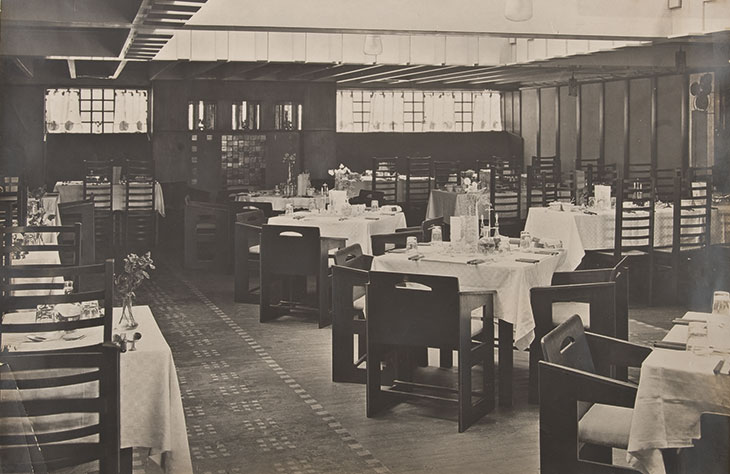
The famous tearooms of Miss Catherine Cranston were born of Glasgow’s Temperance movement – they were intended to divert people from the pull of the pub, and as such they needed their own unique charm. This was provided by Charles Rennie Mackintosh, whose meticulous attention to detail ensured that every inch of these interiors, down to the cutlery, was infused with the sleek modernism of the Glasgow Style. The Willow Tea Rooms on Sauchiehall Street have recently reopened after a two-year restoration, while at the V&A Dundee (opening 15 September) a forensic reconstruction of the Oak Room at the Ingram Street Tearooms will be at the heart of the new permanent display.
The American Bar, Vienna, Adolf Loos
Exterior of the American Bar. Photo: Thomas Ledl/Wikimedia Commons
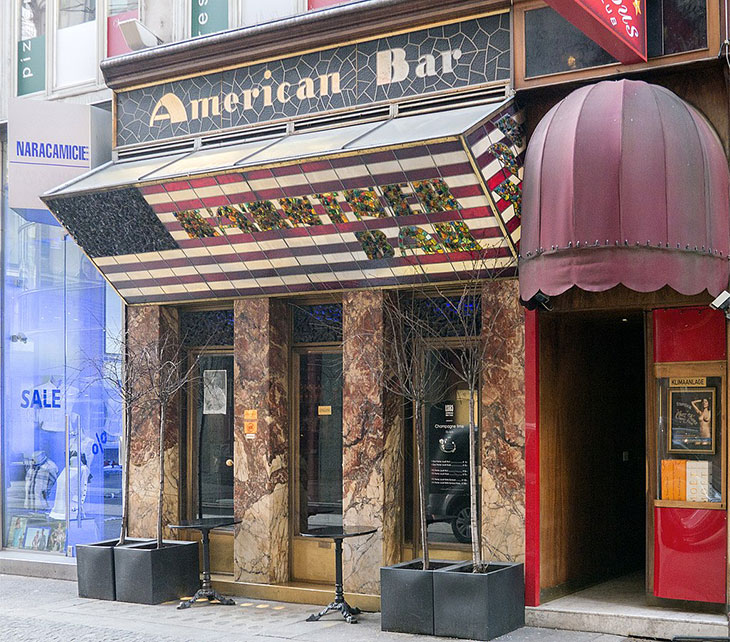
For such a small space, the American Bar in Vienna has had a huge influence on 20th-century design. Its creator, Adolf Loos, may not have believed in ornament, but his bar just off Kärntnerstrasse, and built in 1908, is fitted out in materials – mahogany, onyx and marble – that make it one of the richest, most detailed art nouveau interiors in existence.
Valerie’s Snack Bar (2009), Jeremy Deller
Valerie’s Snack Bar (2009), Jeremy Deller. Installation view at the Hayward Gallery, London, 2012. Photo: Matthew Lloyd/Getty Images
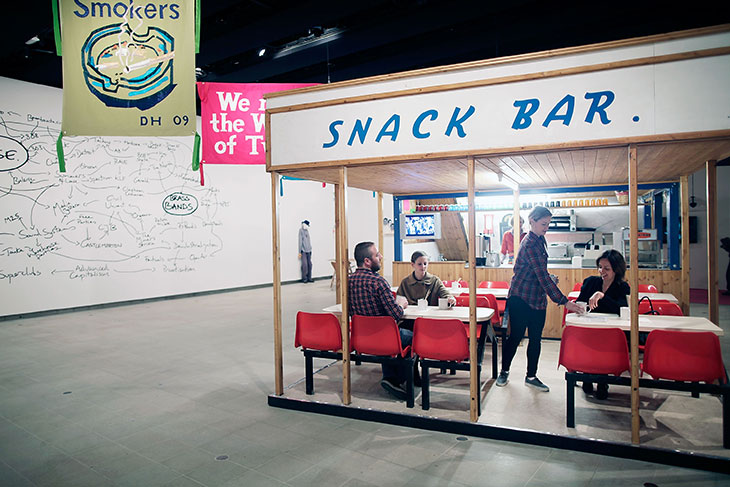
The populist, participatory spirit of Jeremy Deller’s art is neatly encapsulated in Valerie’s Snack Bar, a full-scale replica of a greasy spoon in Lancashire, complete with postbox red plastic seating and signs advertising teacakes or crumpets for £1. Deller’s installation, when it’s on view (whether in an exhibition or installed on the back of a lorry as part of a public procession), is itself a functioning café – well, you can order a free tea.
ArtHouse: A Social Kitchen, Gary, Indiana, Theaster Gates
Courtesy ArtHouse: A Social Kitchen

The roots of Theaster Gates’s ArtHouse: A Social Kitchen, a food and arts hub in Gary, Indiana, can be found in that most famous of artist-run restaurants, Food, set up in New York’s SoHo in 1971 by Gordon Matta-Clark, Carol Goodden, Tina Girouard and others as a space to create food, jobs and a sense of community. Gates’s venture similarly acts as a restaurant and community events space, as well as facilitating jobs in a revitalised commercial and cultural district in downtown Gary. Like Food, ArtHouse suggests that the simple act of sharing a meal can itself be a radical gesture.
Pharmacy 2, London, Damien Hirst
Pharmacy 2 at Newport Street Gallery, London. Courtesy Newport Street Gallery
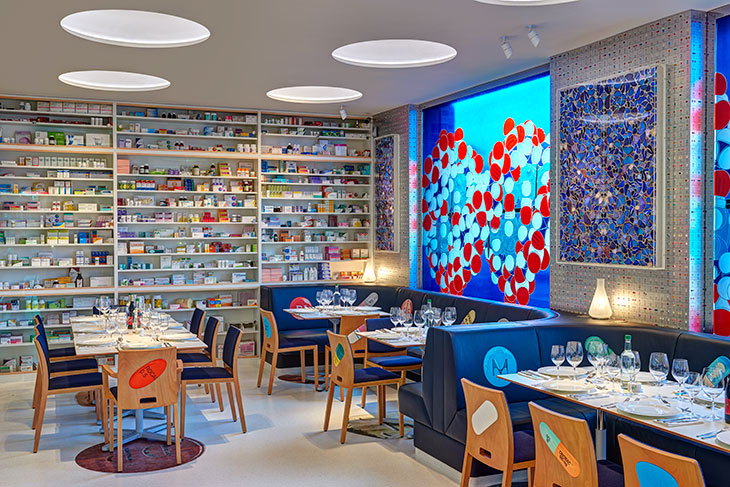
All the pills in the world couldn’t save Damien Hirst’s restaurant Pharmacy, which closed in 2003, five years after opening in Notting Hill (it’s now a branch of Marks & Spencer). Hirst’s own pictures lined the walls of the space, designed to look like a chemist’s shop. Pillboxes were displayed on rows of shelves, and staff wore designer hospital gowns. Not one to be deterred, Hirst launched Pharmacy 2 in 2016 as part of his Vauxhall-based Newport Street Gallery, a collaboration with chef Mark Hix (Hirst’s formaldehyde Cock and Bull sits at the centre of Hix’s restaurant Tramshed in Shoreditch). Here you’ll find pill-box stools, pills on the floor, a neon ‘prescriptions’ sign and stained-glass windows depicting strands of DNA.
The Seagram murals, Mark Rothko
The Seagram Building on Park Avenue, New York City, c. 1960. Photo: George Heyer/Three Lions/Hulton Archive/Getty Images

When in 1958 Mark Rothko was commissioned to create a series of murals for the deluxe Four Seasons restaurant in the new Seagram skyscraper, he described it as ‘a place where the richest bastards in New York will come to feed and show off’. He took the commission in the hope that his paintings would ‘ruin the appetite of every son of a bitch who ever eats in that room’. But the resulting canvases, moody abstractions rendered in a dark palette of browns, reds and blacks, never made it on to the walls of the Four Seasons. In 1959, after dining in the newly opened restaurant, Rothko had a dramatic change of heart, returned his $35,000 fee and took back the works.
RA Café (formerly the Grand Café), London, Leonard Rosoman
RA Café, Royal Academy of Arts. © Agnese Sanvito
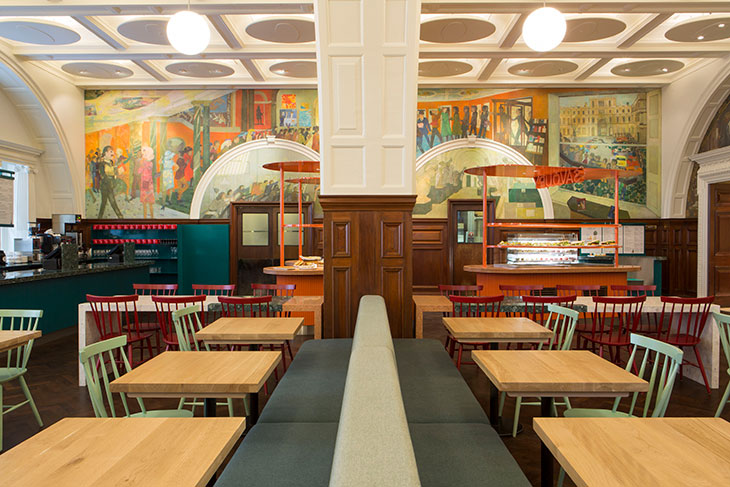
Leonard Rosoman’s closest association as a teacher was with the Royal College of Art, where he taught for more than 20 years. But his most impressive work as an artist – in terms of size, at least – is the mural he painted for the Grand Café at the Royal Academy (he became an Academician in 1960). Upstairs, Downstairs (1986) shows the public and private faces of the RA he knew – a crowd of people piling in to the building to see an exhibition and, below, a life-drawing class full of intent students, at the Royal Academy Schools. The Grand Café has recently been renovated and renamed as part of the RA’s 250th birthday celebrations, but Rosoman’s mural is still the star exhibit.
The Black Friar, London, Herbert Fuller-Clark
Exterior of the Black Friar Pub. Photo:Fæ/Wikimedia Commons

Richly decorated with mosaics, carved panels, and large copper reliefs depicting friars engaged in their day-to-day activities – fishing, drinking and gossiping – the interior of The Black Friar on London’s Queen Victoria Street toes a fine line between the sacred and the profane. It’s really a hymn to worldly pleasures; a bas-relief above the bar, entitled Tomorrow will be Friday, depicts a group of friars catching trout and eels, while a scene of a sleeping monk surrounded by fairies (a drunken hallucination?) bears the legend ‘Contentment surpasses riches’. The pub itself was built in 1875 on the site of a medieval Dominican friary; its interior is the most celebrated work by the Arts and Crafts architect Herbert Fuller-Clark.


